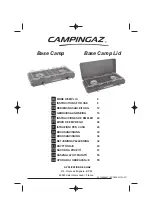
5
CLEANING AND CARE
Choice of burners
For your convenience there is a choice of burners:
•
A small burner for special low heat and slow cooking.
•
A medium burner for normal cooking and simmering.
(one on 4-burner models and two on 5-burner models).
•
A large burner for fast heating and large pots and pans.
•
A wok burner for very fast heating using a wok or
large pot or pan.
To conserve gas, place the pan centrally over the burner
and adjust the flame so that it does not extend past the
edge of the pan (Figure 3). Do not boil food too rapidly.
A vigorous boil will not cook food any faster, and will
waste energy.
Pots and pans
All common pots and pans: aluminium, stainless steel,
cast iron, ceramic etc., may be used on your new gas
model cooktop. Ensure that the pots or pans are steady
and have flat bases to avoid dangerous spill-over of hot
liquids and wasted energy. A wok support has been
supplied with this appliance for use when cooking with a
round-bottom wok. The support is not necessary when
cooing with a flat-bottom wok.
Figure 3
Choice of flame height
Incorrect – flame too high
and will cause gas waste
and possible handle damage.
P
Correct flame height.
Gas saved.
Choice of cooking pan
For a small burner,
use a small pot or pan.
P
P
For a large burner,
use a large pot or pan.
WARNING
CAUTION
Never use asbestos mats, wire mats or grids, aluminium
foil as it can lead to overheating, cracked enamel. The
warranty will be void if these items are used and cause a
failure. Woks should only be used on the wok burner and
wok support trivet.
WARNING
WARNING
Ensure the appliance is off and cool before cleaning.
Enamel
Persistent stains may require rubbing with a nylon scourer
or creamed powder cleansers. Household enamel cleaners
are available, follow the manufacturer’s instructions in
their use.
WARNING
CAUTION
Harsh abrasive cleaners, powder cleaners, steel wool or
wax polishes should not be used.
Stainless steel
NOTE: Ensure any oil is cleaned off the hob before first
use, otherwise it may cause the hob to turn a yellowish
colour.
All grades of stainless steel may stain, discolour or attain an
adhering layer of grime in normal operation. To achieve
maximum surface appearance, stainless steel must be kept
clean by regularly using the following cleaning procedures,
thus ensuring good performance and long service life.
Wash with warm soapy water and rinse with clean water.
Where the stainless steel has become extremely dirty with
signs of surface discolouration, (due to periods of neglect
or misuse) use a stainless steel cleaner.
WARNING
CAUTION
DO NOT use abrasive scourers or steel wool. When
removing these stains be sure to follow the polish or
brushing lines.
Trivets and burners
The burners and trivets are removable for easy cleaning.
NOTE: When refitting the burners, ensure that they are
correctly seated.
Ensure burners are thoroughly dried after cleaning or
spillage. When cleaning the burners, ensure that all the
flame ports are free of any blockage. If necessary, use a
toothpick or brush to clear ports. The outer surface of the
burners have a polished finish and extra care needs to be
taken to avoid scratching this surface during cleaning. In
instances of heavy soiling, it may be necessary to apply a
non-abrasive cleaning compound and rub with a cloth until
the soiling is removed and then finish with a soft, dry cloth.
NOTE: DO NOT place burners in the dishwasher.
Ignition
Gently clean the spark plug and flame safe guard sensor
(where fitted) with a damp cloth to avoid lighting
difficulties. Ensure the electrode is dry before use.
Injector
Ensure the injector remains free of any foreign material.
If necessary, use a thin piece of wire to clear the orifice.
CARE AND CLEANING






































